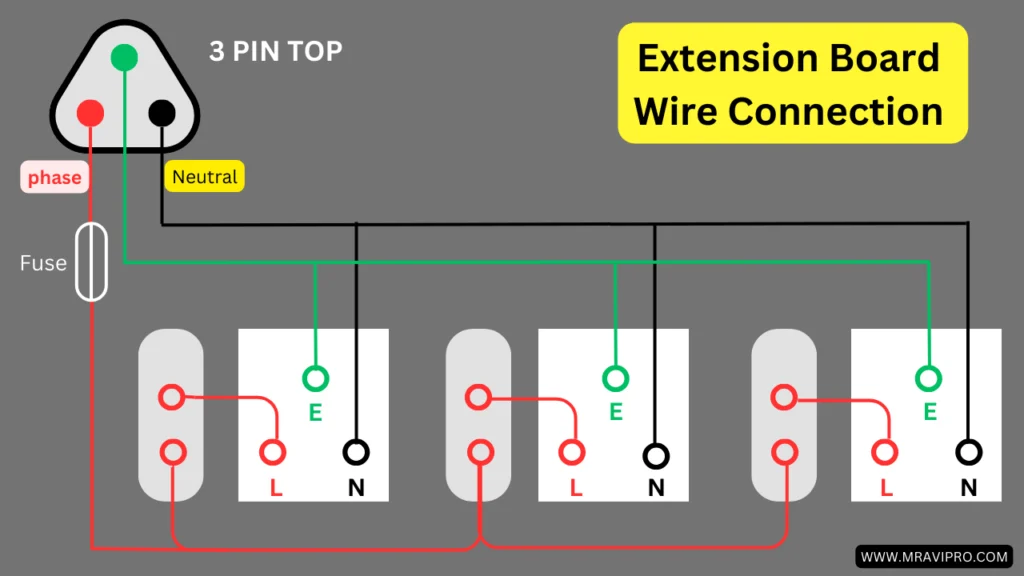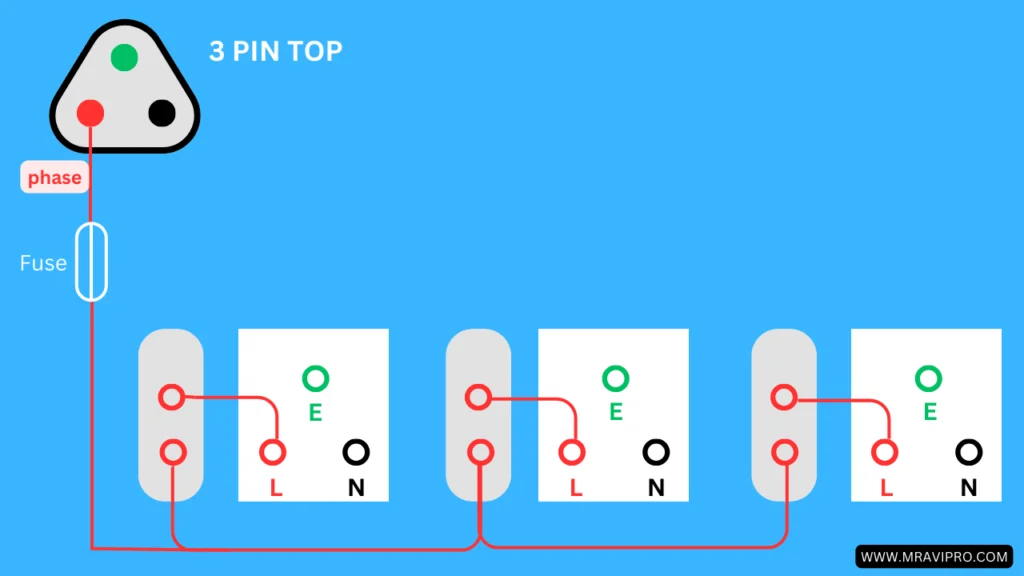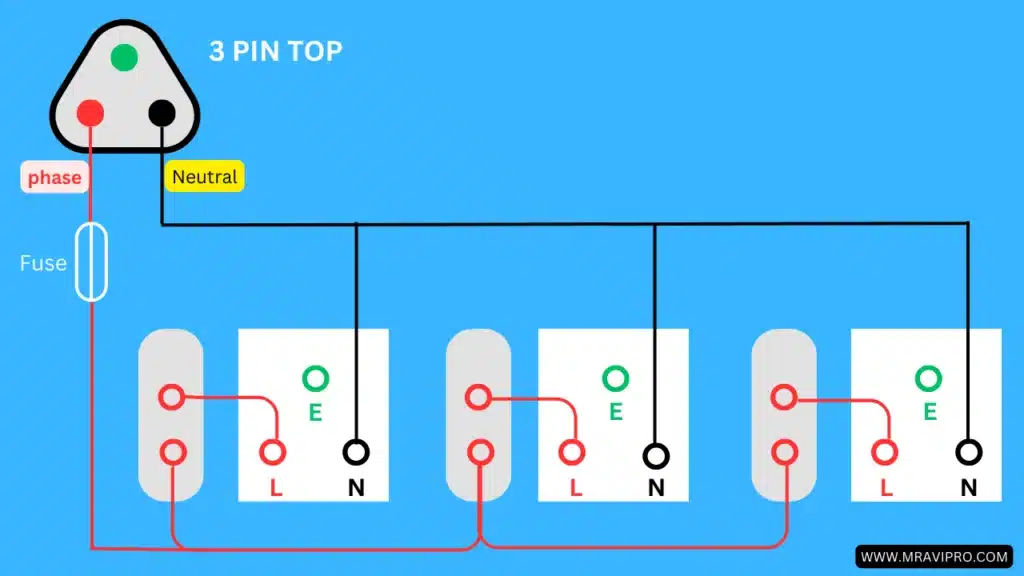Hello friends, how are you all? Today, I introduce you to this blog post. I will teach you how to make an extension board wire connection. I will teach very easily. And I will give a photo of each one. So that it is convenient for you to understand, let’s get started.
We will first discuss a little about the Extension Board. Then I will come to the main topic.

What is an Extension Board?
An extension board can be called a type of device that can power many devices at the same time. It has one plug at one end and many plugs at the other end. TVs, fridges, computers, mobile chargers, and many other things can be run simultaneously through those plugs. The extension board has an advantage; a fuse is installed in it to protect it in case of a short circuit.
What are the advantages and disadvantages of an extension board?
An extension board is a device that allows you to connect multiple electrical appliances to a single power source. There are also some advantages and disadvantages to using extension boards.
Some of the advantages are:
- You can use electricity even if there isn’t a plug nearby. You might think you’re working away from outriggers, but the ability to power your devices is a significant benefit of employing extension cords.
- You can improve the overall brand image of your products. If you are a manufacturer or a seller of electrical appliances, you can use extension boards as a way of extending your brand name and reputation to other product categories.
- You can reduce the perceived risk for consumers. If you have a well-established and trusted brand name, consumers will be more likely to accept your new products connected to the extension board, as they will associate them with the same values and aspirations as your core brand.
Some of the disadvantages are:
- You may overload the circuit and cause a fire hazard. If you connect too many devices to the extension board or if the devices have high power consumption, you may exceed the capacity of the circuit and cause overheating, sparks, or even fire.
- You may damage the devices or the extension board. If the extension board is not compatible with the devices, or if it has poor quality or faulty wiring, you may damage the devices or the extension board itself.
- You may lose the original appeal of your brand. If you extend your brand name to too many product categories, or if the products are not related to your core brand, you may dilute the original appeal and identity of your brand and confuse or alienate your consumers.
Component List Example
5 Pin Socket Female || 3 PIN TOP & Plug Male
![How to Make Extension Board Wire Connection With [7 Picture] Best Tips](https://mravipro.com/wp-content/uploads/2023/10/earthing-phase-1024x576.webp)
Step 1: Component List
In the first step, I will set up the components on my board. And I will set them up well with nut bolts.
![How to Make Extension Board Wire Connection With [7 Picture] Best Tips](https://mravipro.com/wp-content/uploads/2023/10/STEP-1-1024x576.webp)
Step 2: Wire Connect Phase & Switch
The connector below each switch (L-LINE and phase) will be connected to it.
![How to Make Extension Board Wire Connection With [7 Picture] Best Tips](https://mravipro.com/wp-content/uploads/2023/10/STAP-1-wire-1024x576.webp)
Step 3: Wire Connect Switch and 5-Pin Plug
The upper connector of the switch will connect to the (L) connector of the 5-pin plug.

Step 4: Wire Connect Direct Neutral (N)
Now we will connect the neutral wire to our board. We will connect the neutral wire to the (N) connector of the 5-pin plug.

Step 5: Wire & Extension Bread: Complete Processes
In any case, our extension bread is completely ready; there is a little left. Now connect a wire to the (E) connector. E is the earthing wire. You can bury this cable anywhere in the house.
![How to Make Extension Board Wire Connection With [7 Picture] Best Tips](https://mravipro.com/wp-content/uploads/2023/10/How-to-Make-Extension-Board-Wire-Connection-With-7-Picture-Best-Tips-1024x576.webp)
Why is the earthing wire used?
Earthing wire is a type of wire that connects the metallic body of an electrical appliance to the ground. It is a safety measure to prevent electric shocks or fires caused by faulty wiring or power surges. Earthing wire provides a low-resistance path for the excess or leakage current to flow into the earth instead of passing through the user or the appliance. Earthing wire is usually made of copper or galvanized iron and is buried in the soil or connected to a metal plate or water pipe underground. Earthing wire is essential for high-power electrical equipment, such as refrigerators, iron boxes, and TVs.
What is the difference between AC and DC?
The difference between AC and DC is that AC stands for alternating current, while DC stands for direct current. In AC, the electric charge changes its direction periodically, while in DC, the electric charge flows in a single direction. AC is the most commonly used and preferred electric power for household equipment, offices, buildings, etc. because it is easy to generate and transmit over long distances. DC is mainly used to supply power to electrical devices and charge batteries, such as mobile phones, flashlights, electric vehicles, etc because it provides stable and constant electricity.
Some additional sentences are:
- AC can be identified by a waveform called a sine wave, which is a curved line that represents electric cycles measured in hertz (Hz). DC has a straight or dotted line with a plus and a minus sign, indicating the polarity of the current.
- AC can power electric motors that are used in appliances such as refrigerators, washing machines, etc., by creating a rotating magnetic field. DC can also power electric motors, but they require additional components such as brushes and commutators to change the direction of the current.
- AC has a passive parameter called impedance, which is the combination of resistance, inductance, and capacitance. DC has only resistance as its passive parameter. The power factor of AC lies between 0 and 1, depending on the phase difference between voltage and current. DC power factor is always.
How to Make Extension Board Wire Connection Video.
- Read more article: Wireless Key for Motorcycle
FAQ
What is the difference between earthing and grounding?
The difference between earthing and grounding is that earthing means the electrical circuit is physically connected to the earth, which has zero volt potential. In contrast, grounding means the circuit is not physically connected to the earth but still has zero potential with respect to other points. Earthing protects humans from electric shocks, and grounding protects the entire system from malfunctioning. Earthing uses a green wire, and grounding uses a black wire. Earthing is located under the earth pit, and grounding is located between the neutral of the equipment and the ground.
Why is it called a neutral wire?
A neutral wire is a white wire that carries the unused or excess current back to the power source. It is called neutral because it is not energized or connected to any active energy source. It helps to balance the voltage and current in an electrical circuit and prevent overheating or other hazards. The neutral wire is usually attached to the white or silver screw on an outlet or device, while the hot wire (black) connects to the gold screw.
What is the difference between neutral and ground?
A neutral wire and a ground wire are both important for the safety and functionality of an electrical circuit. The neutral wire is a white or gray wire that carries the excess or unused current back to the power source. It is connected to the neutral bus bar in the main panel. The ground wire is a green or bare wire that provides a path for the current to flow to the earth in case of a fault or short circuit. It is connected to the ground rod or metal water pipe. The neutral wire and the ground wire are connected together at the main panel but not at the devices. This ensures that the voltage and current are balanced in the circuit and that the metal parts of the devices are not energized.
What is a phase wire?
A phase wire is a wire that carries the high voltage and delivers it to the appliance or load. It is also called a live wire or a hot wire. A phase wire is usually connected to a neutral wire, which has a low potential, to form a single-phase power circuit. A single-phase power circuit can handle light loads, such as lights and fans. For heavier loads, such as motors and machines, a 3-phase power circuit is used, which consists of three-phase wires and a neutral wire. The 3-phase wires have alternating currents with a fixed time offset between them, which allows more power to be delivered.
How does three-phase power work?
3-phase power is a common method of alternating current (AC) power generation, transmission, and distribution. It is generated by three separate wires, each carrying an AC that is out of phase with the other two by one-third of a cycle. This can create a rotating magnetic field, which can be used to power electric motors and other equipment. Three-phase power is more efficient and economical than single-phase power because it uses less conductor material to transmit the same amount of power at the same voltage.